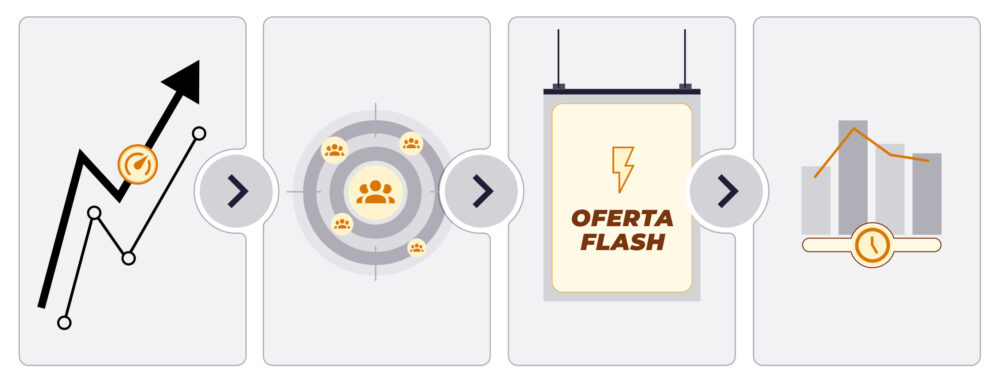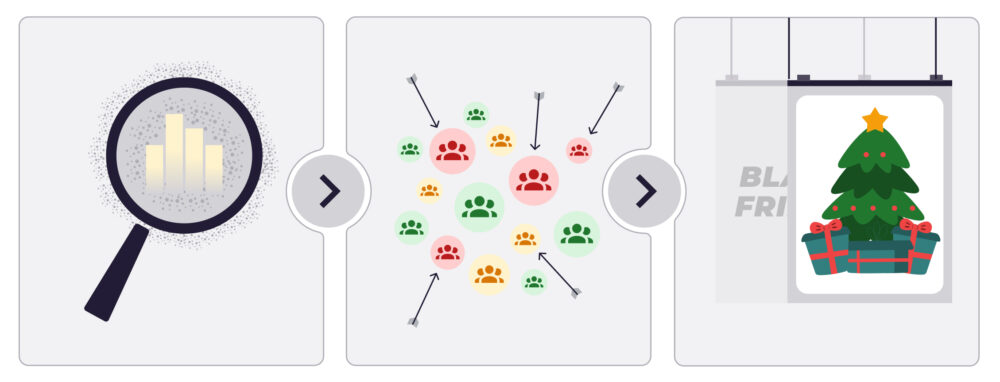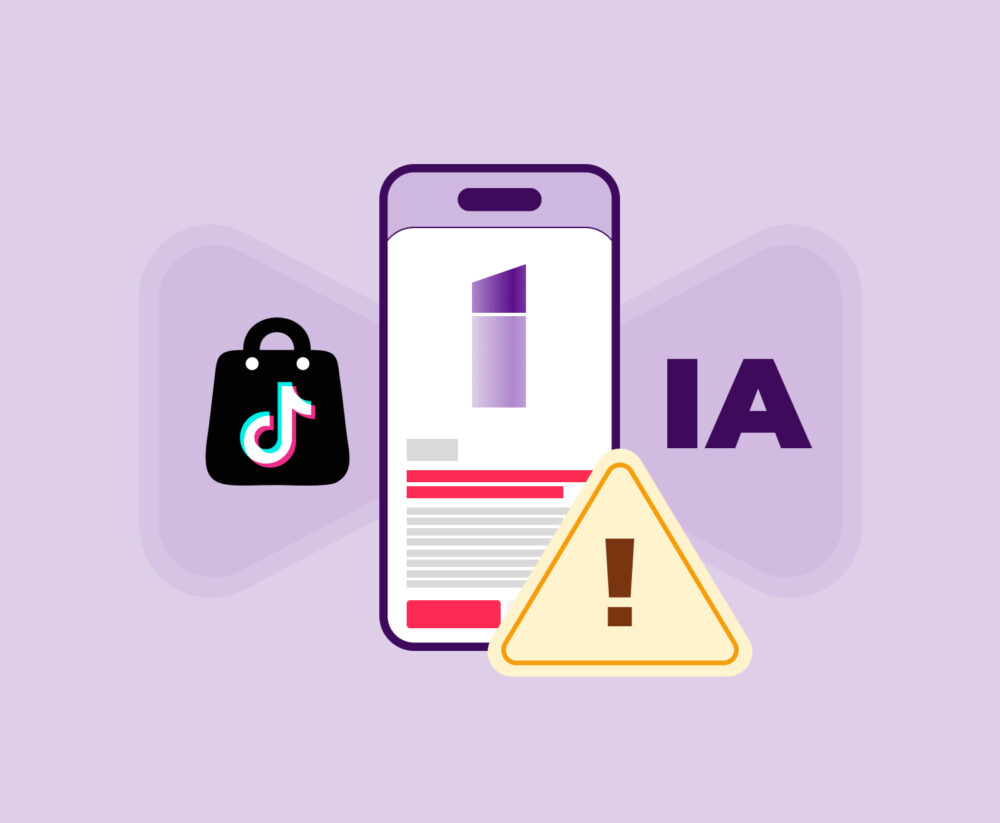Retail Media in Peak Season: How to Optimise Campaigns for Black Friday and Cyber Monday 2025
Every year, the e-commerce calendar has its own summit: the days between Black Friday and Cyber Monday. This two-day event in November marks the kick-off of the most intense shopping season, a period where brands and consumers converge in a frenzy of offers and purchasing decisions. For brands, standing out amidst this digital noise is a monumental challenge. This is where Retail Media has established itself as the most powerful strategic tool.
Unlike other advertising channels, Retail Media allows brands to reach the consumer directly at the digital point of sale (the retailer’s website or app), just when their purchase intent is at its peak. This turns a simple visit into an immediate conversion opportunity.
The figures strongly support this trend. Projections from consultancies like IAB and eMarketer indicate that investment in Retail Media will exceed $160 billion globally in 2025, with sustained annual growth of over 20%. During Black Friday and Cyber Monday, this channel is the epicentre of sales strategy. Preparing in advance will determine the season’s winners.
In this article, we will explore why Retail Media makes so much sense for BFCM 2025, how to optimise your advertising campaigns, and which platforms and trends to keep in mind to make the most of this key retail period of the year.
Why is Retail Media Essential during Black Friday and Cyber Monday?
During the November sales peak, competition for consumer attention is fierce. Advertising costs on social media and search engines soar, and the effectiveness of ads decreases. Retail Media offers a strategic haven with unique advantages that make it indispensable.
- Precise segmentation with first-party data: Retailers possess the most valuable asset in modern marketing: the actual purchase data of their customers. They know what they search for, what they buy, how often, and which complementary products interest them. Using Retail Media allows you to access this intelligence to create ultra-segmented audiences. You can target shoppers who visited your product but didn’t buy, loyal customers who have already bought your brand, or users who have purchased competitors’ products. It’s surgical-precision advertising at the moment of truth.
- Clear measurement and direct sales attribution: One of the biggest challenges in digital marketing is proving return on investment. With Retail Media, attribution is direct and transparent. The platforms show you exactly how many sales each pound invested in an ad generated, as everything happens within the same ecosystem. This “closed loop” eliminates guesswork and allows for the calculation of a reliable return on ad spend (ROAS), facilitating real-time optimisation.
- Heightened purchasing context during peak season. During periods like Black Friday/Cyber Monday, the path to purchase shortens; the consumer is already looking for offers, compares less, and decides quickly. A well-placed ad within a Retail Media environment captures that “hot intent.”
For all these reasons, if a brand wants to gain visibility and conversions during the peak season period, properly integrating Retail Media into its media mix is a competitive necessity.
How to Optimise Your Campaigns?
Success on Black Friday isn’t improvised in November. It’s the result of meticulous planning divided into three critical phases.
Phase 1 – “The Calm Before the Storm” – Preparation (August – October)
This is the period for building the foundations of your campaign. It’s the phase that determines which brands will truly leverage the potential of the peak season.
It is divided into the following stages:
Audit and Learnings from 2024
Analyse what worked and what didn’t in your previous peak season campaign. Examine which retail networks you used, how your bids performed, which products yielded the best results, logistical bottlenecks, stock-outs, etc. If a “product collection” ad type performed well, plan to replicate that strategy. If a keyword didn’t convert, discard it.
This review should also include a competitive analysis. Observe what strategies successful competitors implemented, what positions they occupied in search results, and which promotions stood out.
Strategic Budget Planning
Demand multiplies, and your budget must too. Allocate a specific and significantly larger budget for Black Friday week. Decide how you will distribute the investment: a portion for visibility campaigns (to publicise your offers) and the majority for conversion campaigns (sponsored products). You can also reserve a small percentage for flexibility to boost the best-performing campaigns in real time.
Additionally, consider temporal allocation. The week before Black Friday often offers better acquisition costs than the Friday itself, when competition reaches its peak. Many brands achieve superior results by bringing forward part of their investment to this preliminary period.
Product Page Optimisation
Your product page is your digital salesperson. There’s no point in driving thousands of customers to a poor page. Make sure it’s perfect. Update images with specific Black Friday promotional content, highlighting discounts or benefits. Enrich descriptions with relevant keywords. Verify that all technical elements are working correctly.
Ratings and reviews are also crucial. If some key products have few reviews or low ratings, implement strategies to improve this aspect before the campaign. Consider limited early promotions to generate initial purchases and, consequently, the first positive reviews.
Keyword Strategy
Research and define two types of keywords within the retailer’s search environment. First, general or always-on keywords (“4K television”, “running shoes”) that build long-term relevance. Second, season-specific keywords (“Black Friday deals”, “laptop discounts”, “Cyber Monday gifts”) that will capture the demand of the moment. Start bidding on them weeks in advance to gain positioning at a lower cost.
Prepare lists of negative keywords to avoid wasting budget on irrelevant searches. During high-traffic events, off-target searches can consume resources quickly if not managed proactively.
Stock and Logistics Verification
The most brilliant advertising campaign falls apart if you run out of stock at 10 a.m. on Black Friday. Work hand in hand with your operations team to ensure you have sufficient inventory of your star products and that your logistics are prepared to handle a peak in orders.
Confirm that delivery times are competitive and correctly communicated. During these days, and also looking ahead to the Christmas season, speed of delivery can be a differentiating factor against competitors.
Phase 2 – “The Eye of the Storm” – Execution (November – BFCM Week)
This is the moment of truth. All the prior preparation must translate into tangible results. Agility and constant monitoring will be your best allies.
Activation and Bidding Strategies
As the date approaches, it’s time to be more aggressive. Increase bids for key products, prioritise “best-sellers” or products with a good margin, and modulate the budget so it isn’t consumed too quickly.
Use the dynamic bidding options offered by the platforms to automatically increase your bid when the probability of conversion is high. The goal is to ensure maximum visibility during peak traffic hours.
Advanced Segmentation
Activate the audiences you prepared and leverage all available segmentation capabilities. Launch retargeting campaigns for users who added your product to their basket but did not purchase, both within the retailer’s site and off-site if possible. Create cross-selling (cross-selling) campaigns aimed at customers who have bought from you in the past, offering them complementary products.
Implement differentiated strategies by user type. New customers may require messages focused on the value proposition and trust, while returning customers will respond better to exclusive offers or early access.
High-Impact Creatives
Adapt your ads to the context. Use banners and copy that communicate urgency and scarcity with messages like “Flash Sale – Today Only”, “Last Units with 40% Off” or “Cyber Monday Exclusive”. Make sure you have specific creatives for Black Friday and different ones for Cyber Monday to keep things fresh.
For rich media formats like video or display, ensure the main message is understandable within the first 3 seconds. User attention is fleeting during these days, and immediate clarity determines whether the ad generates interest or is ignored.
Real-Time Monitoring
During this week, campaigns cannot be left on autopilot. Assign a person or team to monitor performance every few hours.
Be prepared to pivot. If a specific product generates more demand than anticipated, reallocate budget from underperforming campaigns. If competitors unexpectedly raise bids on certain keywords, evaluate whether it’s worth competing or redirecting resources to less contested alternative terms. The ability to react quickly is what will maximise your investment.
Phase 3 – “Capitalising on the Aftermath” – Post-Campaign (December)
The end of Cyber Monday marks the beginning of an equally strategic phase: turning the generated momentum into lasting relationships and preparing for the end of the year.
In-Depth Results Analysis
Once the dust settles, dive into the data. How much of the sales increase is actually due to the Retail Media campaign? Spend time analysing in detail what worked and what didn’t. Examine data at a granular level: performance by product, by keyword, by audience segment, and by time slot.
Compare results with established objectives and historical performance. Calculate key metrics like return on ad spend, customer acquisition cost, and the average order value generated by each campaign. This analysis will provide valuable learnings for 2026.
Retargeting and Loyalty Strategies
Users who interacted with your ads but didn’t complete a purchase represent a warm audience. Implement retargeting campaigns with tailored messages: reminders of viewed products, additional incentives to close the sale, or limited-time offer extensions.
For those who did buy, it’s time to build their loyalty. Create audiences of BFCM shoppers and launch campaigns for them in December with complementary products, new arrivals, or thank-you messages. Turn a one-off purchase into a long-term relationship.
Preparing for the Christmas Campaign
Many brands make the mistake of completely deactivating their campaigns after Cyber Monday. December offers significant opportunities: last-minute shopping, Christmas gifts, and consumers who now have clarity on which products led sales during Black Friday.
Adjust messages to reflect the Christmas season and consider discounts on express delivery to capture late shoppers. Products that sold out during Black Friday can be restocked and promoted again with renewed inventory.
Key Platforms and Trends
In the week of BFCM 2025, the Retail Media ecosystem will be more diverse than ever. But platforms like Amazon Ads, Mercado Ads (in Latin America), Carrefour Links, Promocionar from El Corte Inglés or Walmart Connect will continue to be the main battlegrounds.
Trends to watch closely include:
- Artificial Intelligence in optimisation: Platforms will use AI to automate bidding, suggest budgets, and create predictive audiences with ever-increasing efficiency.
- The power of video: Streaming video ads within retailer platforms (like Amazon Prime Video Ads) or on product pages themselves will become a premium format for telling a brand’s story.
- Off-site Retail Media: Retailers will export their valuable data to allow brands to reach their audiences on external platforms like social media or news websites, combining the best of both worlds.
- Expansion of the in-store format: in-store screen media, digital signage, screens that combine online and offline shopping. This will reinforce the omnichannel experience during these days.
- Mobile-first priority and speed: consumers in peak season don’t wait; pages must load quickly, the offer must be clear, and the ad must lead to a smooth shopping experience.
- First-party data and privacy: with the progressive phasing out of third-party cookies, retailers who own their own data are becoming increasingly valuable to advertisers.
In short: the platform you use matters, but what’s most important is how you fit your strategy—audience, creative, bidding, and measurement—within that environment and how you prepare to adapt.
Retail Media on Black Friday and Cyber Monday: The Key to Ending the Year with Results
The busiest commercial season of the year demands a strategic rather than a tactical approach. The Retail Media channel offers brands a significant advantage: reaching the consumer at the point of purchase, with good data, greater visibility, and a more transparent return. While preparation, execution, and analysis require coordination, resources, and adaptability, the results justify the investment.
For Black Friday and Cyber Monday 2025, it’s not enough to simply “switch on ads”. You need to think about how your Retail Media campaigns reinforce your entire marketing mix, how they connect brand and conversion, and how the learnings from this season bring you closer to your long-term goals.
Invest the necessary time and effort now, optimise intelligently, and measure rigorously: this will put you in a better position to harness the full power of Retail Media during one of the key windows of the year.








